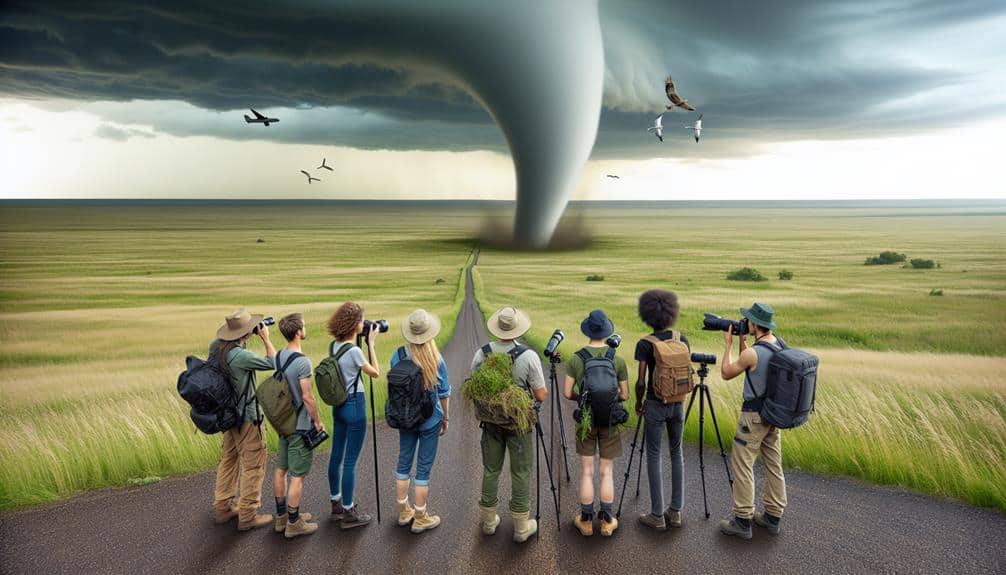As storm chasers, we've got to immerse ourselves in local beliefs and practices to foster cultural respect and effective collaboration with communities. We should respect traditional practices, obtain necessary permissions, and communicate with cultural awareness. By minimizing our environmental impact, we honor nature and ecosystems. Learning from indigenous knowledge sharpens our observational skills and enhances community preparedness for storms. Collaborating with locals helps build resilience and promotes collective action. Understanding these elements guarantees a respectful and sustainable approach to storm chasing. There's a lot more to explore about the symbiotic relationship between storm chasing and cultural respect.
Key Points
- Engage with local communities to understand their customs and beliefs related to weather.
- Obtain permissions from local authorities and community leaders before entering their lands.
- Demonstrate cultural sensitivity and respect for local traditions and rituals.
- Incorporate indigenous knowledge and practices into storm chasing activities.
Understanding Local Beliefs
As storm chasers, it's crucial for us to immerse ourselves in local cultures to grasp the deeply ingrained beliefs that influence how communities react to extreme weather events. This isn't solely about observing from afar; it involves engaging with individuals, hearing their narratives, and viewing the world from their perspective. Cultural awareness is vital. Every community possesses distinct traditions and customs that direct their interactions with nature.
When we step into a new area, we must be mindful of these local traditions. For example, some communities may have rituals or practices they trust safeguard them from storms. Ignoring these customs not only shows disrespect for their beliefs but also obstructs our ability to collect precise information.
Collaborating With Local Communities
Building on our understanding of local beliefs, we can foster meaningful partnerships with communities by actively involving them in our storm chasing efforts. Community engagement is crucial; it's not just about us observing storms, but also about integrating local knowledge and perspectives.
By collaborating, we gain invaluable insights into weather patterns and cultural nuances that can enhance our practices and safety measures.
We should approach these communities with respect and openness, demonstrating cultural sensitivity. This means listening to their concerns, understanding their experiences with storms, and valuing their traditional knowledge.
Engaging locals can transform our work from an intrusive activity into a collaborative venture. It's about creating a reciprocal relationship where both parties benefit, fostering trust and mutual respect.
In our engagements, we must make sure that our interactions are respectful of the community's way of life and their values. This includes being mindful of the language we use and the way we present our objectives.
By doing so, we build a foundation of trust that not only enriches our storm chasing experiences but also empowers local communities.
Together, we can approach storm chasing as a shared journey, rooted in understanding and cooperation.
Respecting Traditional Practices
To truly honor traditional practices, we must immerse ourselves in the cultural contexts of the communities we engage with during our storm chasing activities. Understanding these contexts involves more than surface-level observations; it requires genuine cultural sensitivity. We need to recognize and honor the traditional customs that shape local perspectives on weather phenomena.
By embracing this approach, we can guarantee our actions align with community values.
Here's how we can practice cultural sensitivity:
- Educate Ourselves: We should learn about the community's history, rituals, and beliefs related to storms. This knowledge helps us appreciate their perspective and avoid actions that might unintentionally offend.
- Engage Respectfully: When interacting with community members, it's essential to approach conversations with humility. We need to listen more than we speak, showing respect for their wisdom and experience.
- Observe Protocols: Every community has specific protocols regarding sacred sites and practices. Adhering to these guidelines demonstrates our respect for their traditions and avoids potential conflicts.
- Adapt Our Practices: Flexibility is key. We must be willing to modify our storm chasing methods to align with local customs, ensuring our presence is non-disruptive.
Obtaining Necessary Permissions
Respecting traditional practices naturally leads us to the importance of obtaining necessary permissions from local authorities and community leaders before commencing any storm chasing activities. When we engage with communities, we need to show cultural sensitivity and respect for local customs. This isn't just a bureaucratic step; it's an essential part of building trust and cooperation. By involving community leaders, we gain insights into local traditions and practices, making our presence less intrusive and more respectful.
Permission protocols vary widely from one region to another, shaped by historical contexts and social norms. We must familiarize ourselves with these procedures to make sure we're not inadvertently disrespecting the communities we visit. A proactive approach to community engagement can open doors, providing us with valuable local knowledge that enhances our storm chasing experience.
Understanding and adhering to local customs can also help mitigate potential conflicts and misunderstandings. By honoring these protocols, we demonstrate our commitment to ethical storm chasing practices. This helps us forge stronger, more respectful relationships with the people whose lands we traverse. In doing so, we not only enrich our own experience but also promote a more inclusive and harmonious approach to storm chasing.
Minimizing Environmental Impact

As storm chasers, it's important we acknowledge the environmental footprint of our activities and work hard to minimize any negative impacts on the landscapes we explore. Our pursuit of nature's most powerful phenomena must be balanced with respect for the environment and the communities we encounter. By adopting eco-friendly strategies, we can preserve these spaces for future generations and maintain harmony with local cultures.
To minimize our environmental impact, we can implement the following practices:
- Reduce Vehicle Emissions: Opt for fuel-efficient or electric vehicles to decrease pollution. Carpooling with fellow storm chasers can also reduce the number of vehicles on the road.
- Leave No Trace: Follow the principles of Leave No Trace by packing out all trash, avoiding damage to vegetation, and staying on established roads and trails.
- Eco-Friendly Equipment: Use eco-friendly gear and supplies. For example, solar-powered equipment can reduce dependence on fossil fuels.
- Community Engagement: Engage with local communities to understand and respect their environmental concerns. This can include participating in local conservation efforts or educational programs.
Communicating With Cultural Awareness
Understanding and respecting the cultural norms and communication styles of the communities we encounter enriches our storm chasing experiences and fosters mutual respect. As storm chasers, we traverse diverse regions, each with its own unique cultural fabric. Recognizing these differences demands cultural sensitivity and a commitment to effective communication.
When we approach a new community, it's fundamental to understand and adapt to their communication preferences. Some communities value directness, while others might appreciate a more nuanced and indirect approach. By observing and engaging respectfully, we can build trust and rapport, essential for gathering accurate and valuable information.
Our presence can sometimes evoke curiosity or concern. Addressing these reactions with empathy and openness helps bridge gaps. We should ask questions and listen actively, ensuring our interactions don't come off as intrusive or dismissive. This mindful approach not only aids in our data collection but also showcases our respect for their way of life.
In essence, our storm chasing endeavors aren't just about the pursuit of atmospheric phenomena but also about honoring the human landscapes we traverse. By prioritizing cultural sensitivity and effective communication, we enhance our understanding and create meaningful connections along our journey.
Learning From Indigenous Knowledge

Drawing from the deep reservoir of Indigenous knowledge, we can gain invaluable insights into weather patterns and environmental cues that have been observed and interpreted over generations. Indigenous perspectives offer a holistic understanding of storm safety, deeply rooted in an intimate relationship with the land and sky. By integrating this wisdom with modern storm tracking technologies, we can foster a more all-encompassing approach to storm chasing.
Indigenous communities have long practiced cultural adaptation to survive and thrive in diverse and often harsh environments. Here are four key lessons we can learn from their approaches:
- Observational Skills: Indigenous knowledge emphasizes sharp observational skills, noting subtle changes in animal behavior, cloud formations, and wind patterns to predict weather changes.
- Community Preparedness: Storm safety involves communal efforts, where knowledge is shared, and collective action is encouraged to protect the community.
- Sustainable Practices: Indigenous storm tracking often aligns with sustainable practices, ensuring that actions taken today don't adversely affect future generations.
- Respect for Nature: Indigenous perspectives teach us to respect nature's power, fostering a healthy caution that can enhance our safety measures.
Frequently Asked Questions
What Gear Is Essential for Storm Chasing in Different Regions?
When it rains, it pours—safety precautions and equipment are key. We must consider regional variations in our preparation, ensuring we have the right gear for tornadoes in the Midwest or hurricanes in coastal regions.
How Can Storm Chasers Ensure Their Safety During Extreme Weather Events?
We must follow emergency protocols and maintain constant communication. Embracing cultural sensitivity and etiquette guarantees we're respectful while staying safe. Analyzing local practices helps us understand and adapt, enhancing both safety and our storm chasing experience.
What Are the Best Times of Year for Storm Chasing?
We chase storms during peak storm chasing seasons, typically spring and early summer, when weather patterns explode with fury and drama. These times offer the most thrilling, freeing experiences, immersing us in nature's raw, untamed power.
What Technology Is Most Useful for Predicting Storm Patterns?
We rely on satellite imagery and meteorological models to predict storm patterns accurately. These technologies give us the freedom to anticipate weather changes, ensuring we can safely navigate and document storms in our storm-chasing adventures.
Are There Specific Vehicles Recommended for Storm Chasing?
Did you know that 60% of storm chasers use customized vehicles? We often prefer these due to their durability and adaptability. However, we must consider cultural considerations when selecting and modifying these vehicles for diverse environments.


